One important decision for any bride is the wedding dress to wear, especially if she is Jewish, given the Judaism dictations on modesty. Even as more couples begin to embrace modernism, the gown choice still relies on the bride’s religion and culture. We take a look at the kosher wedding gowns for a Jewish bride.
So, what do Jewish brides wear? The dress that the bride wears depends on her Jewish denomination and her particular synagogue; however, most requirements are the same. A modern Jewish wedding dress has to be white to symbolize the purity of the bride’s heart and intentions as she enters the marriage. The dress should also be modest to cover some parts of the body like the collarbone, knees, and elbows. Another important aspect of the dress is that it has to be veiled, which is important for the Bedeken ritual.
A wedding is one of the most meaningful days for any bride, so one must look their best at such an occasion. However, the dressing mode has to be in line with religious requirements. We went on to find out the various dresses that Judaism and most Jewish brides find appropriate for a Jewish wedding ceremony.
What Does Judaism Say About the Jewish Wedding Dress?
There is always a rich history behind the Judaic code of conduct. You may question certain aspects of the traditions, such as choosing the wedding dress color and whether the bride must wear a veil. What is the reason behind these customs? We take a brief look at the history behind the Judaic wedding gown.
The white gown is synonymous with the Ashkenazis, who obtained the tradition from the surrounding Christians. Over the years, the Jewish have adopted the idea that the white wedding dress symbolizes the bride’s purity. To date, the Jewish relate the color to the purity of heart and intentions.
Therefore, the bride wearing white is her way of showing that she is entering the sacred institution of marriage while pure. Similarly, the Jewish consider the wedding as a Yom Kippur where the almighty forgives the bride and groom’s sins. So, wearing white means the forgiveness of sin and the start of a new chapter.
Another important wedding tradition is the veiling of the bride, which is necessary for the bedeken ritual. Here, the groom goes to the bride and veils her; to signify that he is only interested in the bride’s inner beauty and not the outward appearance. It is also vital to ensure that the groom is marrying the right person, so he does the veiling himself.
In the modern world, the gowns are more revealing than the traditional wedding dress. On the contrary, Judaism encourages the brides to be modest and observe kosher; thus, showing too much skin may violate most Jewish rules.
A misconception is that religion may deny the believer a chance to be stylish and express a personal sense of style. The truth is, the religion gives the bride the liberty to pick out any stylish gown she fancies, as long as she feels comfortable and she is modest enough to stand at the chuppah.
However, as we are soon going to see, different Jewish denominations have different requirements for their brides; some are stringent, while others are more relaxed. Let’s see what some religions encourage their brides to wear on their big day.
Denominational Requirements for a Jewish Wedding Dress
Every Jewish woman would want to have the perfect dress for her wedding, a gown that reflects her style and personality. However, she has to adhere to her religion’s rules regarding how her dress should look. The main factor to consider in Judaism is modesty, a rule that she has to follow. If you are unsure about what your denomination requires of you, here are some tips to help you choose a wedding dress that is kosher.
Liberal Jews
This denomination is known to be more relaxed in matters of Jewish customs and traditions. The same case applies to their rules of a bride’s wedding gown choice; therefore, a liberal bride may have more freedom to pick out a wedding dress. This way, there are no restrictions on how much skin she shows or how stylish the gown is.
The bride may choose a sleeveless dress or top it with a shawl or jacket to cover her chest. You may notice that most liberal brides look like the modern-day contemporary bride. Some liberal Jews can allow the gown to be of any other color other than white, but a bride can incorporate the white color as a sign of purity.
Conservatives
Conservative Jews require that the bride wears a wedding dress with long sleeves. Here, she may wear a wedding dress with sleeves covering either the entire arm or three-quarters of the arm. Similarly, she should ensure that the shoulders are well covered, and some synagogues encourage that she limits or does away with jewelry.
These traditions have been present for centuries, but people nowadays prefer an improved version of the traditional long sleeved wedding gown. As much as the conservative group is more liberal than the orthodox, they still encourage the bride to be modest and presentable since the wedding is a Holy ceremony.
Orthodox Jews
In this denomination, there are greater restrictions for the bride in choosing a wedding dress; conditions put in place by the Rabbis to conserve the Holiness of a wedding ceremony. Orthodoxy restricts its brides to adhere to long-sleeved bridal gowns; the sleeve may cover the whole arm or at least three-quarters of it as long as it covers the elbows. Orthodox Jews also require that the bride wear a dress with a high neck-line to cover the naked skin above the chest.
Another condition is that the dress should be longer (below the ankle). It can also have a long tail and simple embroidery patches all over it to match the dress’s color. The religion also discourages gowns with bare backs, although you may use a wedding jacket of the same color as the dress to cover your back. The Orthodox rules are clear that a wedding gown should be decent and honor the faith.
Tips for the Perfect Jewish wedding Dress (With Pictures)
Your choice of a wedding dress depends on your Jewish affiliation since some groups are more stringent with their rules than others. Moreover, the particular synagogue you belong to also has a say about your wedding dress.
Therefore, the best cause of action is to observe what other brides of the synagogue wear and consult with your rabbi on the best way to go. Whatever the rules may outline, we will still help you find the perfect dress for your wedding. Please take a look at what we have sampled for you.
The White Wedding Dress
To be on the safe side, we advise that you avoid colored dresses (always go with white). Judaism dictates that the white gown symbolizes the bride’s purity and sanctity of the ceremony, so going against this may be deemed as a violation of the law. Besides, a white gown is extremely elegant for any wedding like this gown in the picture below.
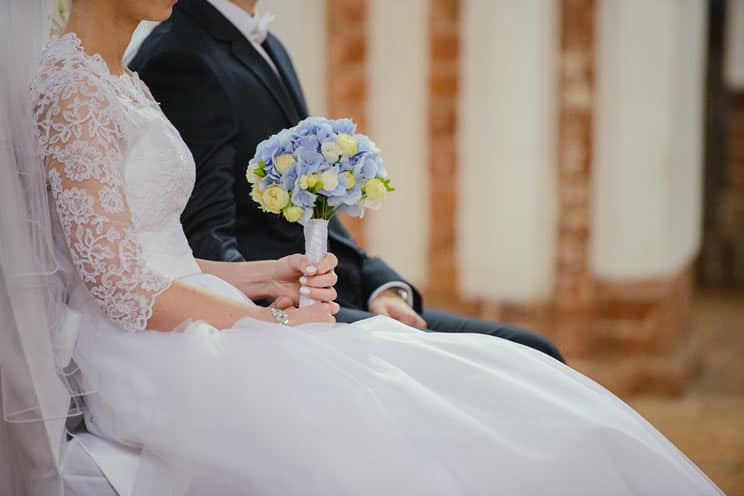
In contrast, some brides, such as the Mizrahi brides, may wear colored gowns to signify that the ceremony is a joyous occasion.
The Veil
Apart from adding elegance to your dress, the veil is in line with the Jewish customs of the bedeken ceremony; hence, most synagogues require that you have a veil like in the picture below.
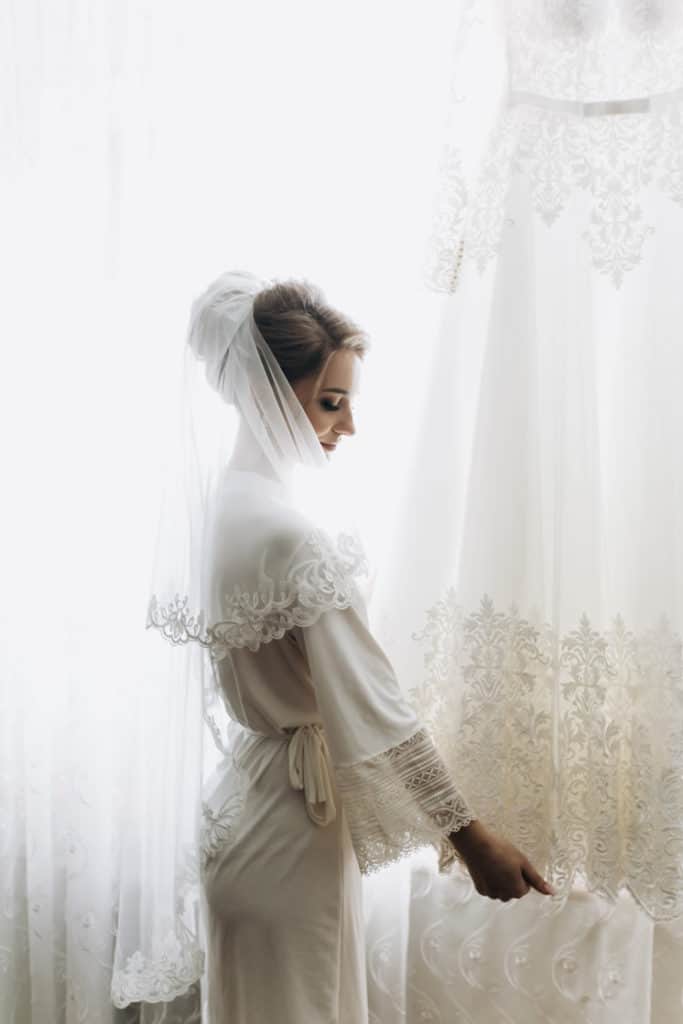
The believers link the veil to the scriptures of Rebekah and Leah’s story, so having it concurs with Jewish requirements.
Covering
On the safe side, you may choose a wedding dress that is less revealing to your arms and shoulders like these dresses.
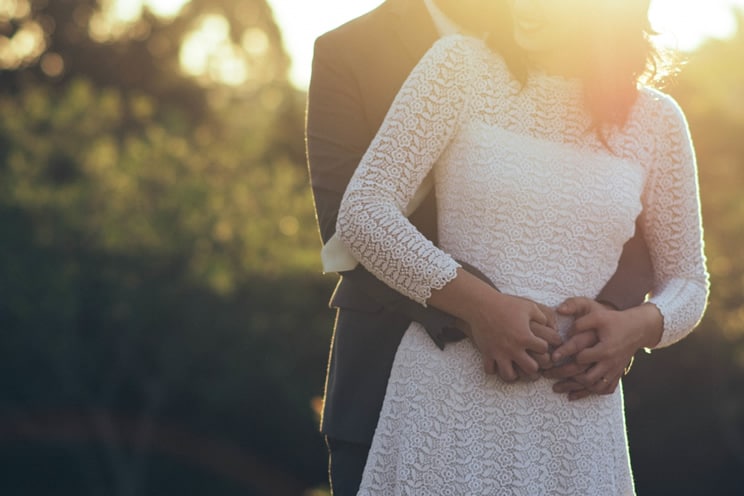
The sleeve must cover the elbow and have a perfect finishing touch of a nice fabric that may bring about an elegant feature; it can make your wedding gown unique and attractive.
The sewing on the sleeve can have flowers or laces the whole length or at the edges.
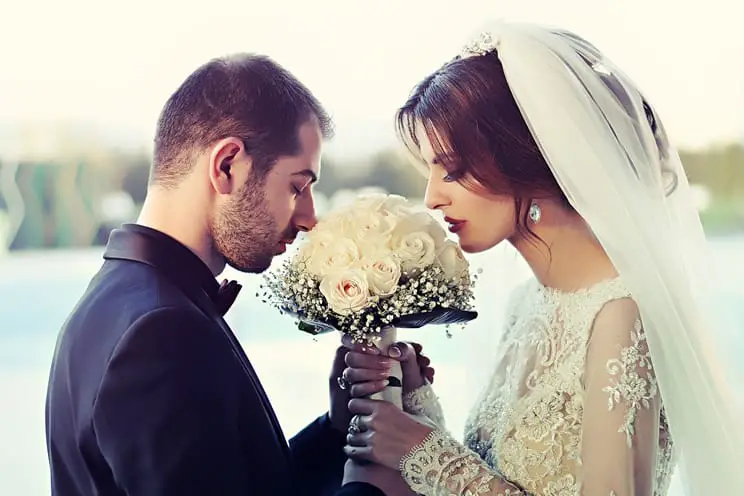
If you still wish to wear a strapless or bareback dress, the best way to play around with your style is to wear a wrap like the bride above or a bolero jacket. The jacket may be a bolero style or of waist length. This style ensures that you wear the perfect dress and still be modest.
Wearing a cover-up for the dress means that you can easily remove it at the end of the ceremony as you go into the reception, which is the merrymaking part of the wedding. Most brides use this trick to get away with a revealing dress.
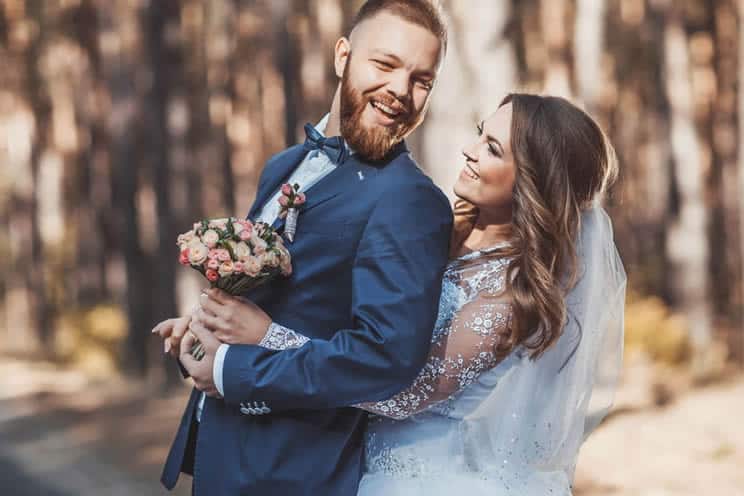
Similarly, if your budget allows it, you can opt for two dresses; a decent one for the chuppah and a less modest one for the reception. The key is to find a cover-up that goes well with your dress. The best option is to have the same designer of the dress to do your wrap or shawl.
However, if you are buying a ready-made dress, ensure that you select a complementing jacket; otherwise, the two pieces may not match. The covered style is very common in Europe, as most brides find it playful and state that it is just like having two dresses in one.
Alterations
You may wish to alter your dress at the neckline or sleeves. Similarly, the dress may be inherited or gifted but does not meet the Jewish modesty criteria. Ask your designer to alter the dress for (you as long as the change is possible).
Of course, a great designer will find his/her way around such tasks; He/ she may make the sleeves and the neckline as short or long as you wish. All you need to do is dig a little into your pocket for that amazing dress.
Dos and Don’ts for a Jewish Wedding Dress
When it comes to wedding dresses, the Conservatives, Orthodox, and Reformists have their conditions. The Reformists have very minimum restrictions, while the conservatives may require the bride to have a dress that covers the elbows, the chest, and the shoulders; this is their standard of modesty.
The Orthodox, on the other hand, are more stringent with their requirements, so they have so many restrictions when choosing a bridal dress.
This denomination requires that the bride covers arms with long sleeves, and the dress has to at least be of ankle length. Lastly, the bride’s back and chest must be well covered. Let’s take a look at some general dos and don’ts for a Jewish bridal dress.
Dos
1. Make sure to consult your rabbi or the synagogue before deciding on your wedding dress; he may give you a catalog of all the possible dresses for a Jewish wedding.
By finding out what requirements there are for a perfect religious wedding, you will never go wrong with your dress, and you will not be on the wrong side with the rabbi. You can still get your dream wedding dress that adheres to the guidelines of the faith.
2. Customize your wedding dress if it is too revealing or needs any alterations. You can take it to a professional designer to make adjustments to ensure that it is modest enough for the ceremony. This way, you get a perfect wedding dress that is still kosher.
3. You can lend your wedding gown if you wish to reduce cost; we know how expensive a wedding dress can be. Since not everyone is capable of buying a stylish wedding dress, there is an alternative.
For instance, Gamach, a gown lending service, allows a bride to have a wedding dress of her dreams by lending out a dress, which is cheaper than buying it. The bride may rent the gown and return it in good condition or opt to keep it.
4. Veiling is a necessary aspect of a Jewish wedding dress, especially if the couple will have the bedeken ritual. The tip is to have a simple veil that still matches your wedding dress’s style and color.
5. When buying a wedding gown, research for the boutiques that have a selection of decent wedding dresses. Most bridal shops offer a selection of more modern gowns that are not necessarily kosher. The best action may be to ask whether the synagogue has a catalog of kosher wedding dresses.
6. As much as you wish to have a modest wedding dress, always let your style show on your big day. You can still have a wedding that you have always wanted, even if there are certain restrictions.
If you are an Orthodox Jew, you can still find tricks to honor your matrimonial ceremony at the synagogue and have the moment of your life. For instance, the Orthodox do not allow the wearing of revealing attire; thus, you can wear a less revealing dress for the ceremony and wear a different one at the reception. You can throw on a removable cover up to cover some revealed body parts.
7. Ensure that your wedding dress can serve the purpose of the main ceremony and the reception. Some brides go the extra mile to have two wedding dresses to serve the two purposes.
There is a lot of merrymaking at the reception; hence, you should have an easy dress to move around in. We advise wearing a removable cover-up. This way, you can take it off at the reception so that you can enjoy other activities like the hora.
Don’ts
1. Don’t expose too much skin; the synagogue may find such dressing non-kosher. Traditionally Judaism doesn’t accept revealing wedding gowns, for instance, strapless gowns or those that show a lot of naked skin on the back, neck, and shoulders.
A proper Jewish wedding must be decent so that it reflects the sanctity of the ceremony. However, the Reformist Jews may allow such a dressing code where the bride can wear a wedding jacket to cover up if she’s uncomfortable.
2. Don’t pick a colorful wedding gown before consulting your rabbi. Normally, a Jewish bride wears a pure white gown to represent the purity of heart and intentions. Nevertheless, certain Jewish groups such as the Sephardic and Mizrahi wear headgears and gowns of mixed colors during weddings. But in most Judaic denominations, the white wedding gown is still synonymous with the ceremony’s purpose.
Final Word
Each denomination of Judaism has its guidelines concerning the choice of a bridal dress. Some sections of Judaism are strict, while others have relaxed conditions or may have no restrictions at all.
Although ancient Jews have their principles on how a bridal dress should look, it has to be white and decent (covering the bare skin on your arms, chest, and legs). Doing so means honoring and respecting your faith.
We also advise that you stay on the safe side, the bride should consult with her rabbi on the best choice of a wedding dress. It should also be timely-done to get the go-ahead to get your gown ready.
Seeking your Rabbis’ guidance is vital since every synagogue may have various tips and reservations about the choice of a bridal dress. Doing this allows you to make adjustments to your dress according to the dictations of your synagogue.
